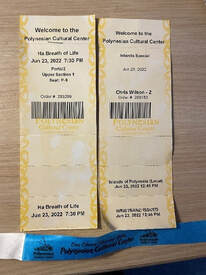 I was impressed with the Polynesian Cultural Center. It seems like a cultural Disneyland, but it's owned by the Mormon Church and staffed by Brigham Young University students. So on the one hand, we expected the cheesiness that apparently appeals to tourist; but on the other hand, we expected religious messaging to mar the presentation. I was impressed with the limited amount of cheese and the complete lack of religious messaging anywhere that I could detect. What I know about Mormonism comes from Rob Ruck's book The Tropic of Football: The Long and Perilous Journey of Samoans in the NFL and Arthur Conan Doyle's A Study in Scarlet. Of course the first is recent non-fiction, while the latter is an old fiction book. But the upshot is that Mormonism doesn't operate the way Christianity does. I've known a lot of Mormons because of their missionary style. My impression is that they go abroad to do service work and set an example but do not actively convert. So a lot of folks like the cultural experience and go into anthropology. A Mormon kid we met had the pule tattoo, which he'd received to settle him down apparently, and he told us that Mormons don't prohibit tattoos. They usually advise against them, but they are OK with cultural tattoos, which is what they consider Samoan tattooing. This is different than what Samoan Mormon kids in American Samoa who accompanied a non-Mormon friend to get tattooed, but I haven't checked this anywhere else. 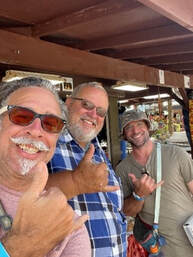 Thanks to Chris (middle) and his wife Patricia (not pictured) for hooking us up! Thanks to Chris (middle) and his wife Patricia (not pictured) for hooking us up! The great thing for us about the PCC is that we were looking for Samoans to interview, and the easiest way to identity Samoans in Hawaii without just asking (which can be weird and potentially insulting for a variety of reasons) is to go to the Samoan Island exhibit at PCC because each cultural island is staffed by students from that island. The catch is that PCC is expensive, and we didn't want to pay to go in and look for people to interview, especially since we were skeptical of this tactic at first. So we went back and forth between the main entrance and BYU campus behind PCC looking for folks and kept getting steered by to PCC. Finally, we went in and stopped by the kiosk owned by friends of Tricia Allen (more on her later), who promptly offered to comp us in for both the park and the evening show (this happened again later in the month when I returned with my wife--we arrived with malasadas the second time, but the effect was the same--having connections is the best!).
0 Comments
 Fresh manapua was delightful but nearly as amazing as Leonard's malasadas (Portuguese donuts) that we picked up the next time. Fresh manapua was delightful but nearly as amazing as Leonard's malasadas (Portuguese donuts) that we picked up the next time. Picked up fresh manapua from Island Manapua Factory in Manoa, just down the road from our room in the East-West Center on University of Hawaii and headed over to TT's parents' house. We were there to pay respects to and watch Su'a Peter Sulu'ape tattoo. Su'a Peter is 8th generation tufuga ta tatau in 'Aiga Su'a, or 8th in a line (according to an interview I conducted with his father in 2019) Samoan master hand-tap tattooist from the Su'a family. The Sulu'ape family have maintained the Su'a tradition for several generations. TT grew up with the Sulu'apes, and she and Peter call each other brother and sister and each others' parents mom and dad. Su'a Alaiva'a Petelo Sulu'ape, Peter's father, explained things to me similarly when I interviewed him in 2019--he has many kids, some of whom are biological children and others he raised or helped raise. Football fans would recognize TT's last name, but I'm sticking with initials here to give her family some relief from the panoptical gaze of football fans. She is the manager of Sulu'ape Skinz, Su'a Peter's handtap tattoo business, and also married to the uncle of at least one professional football player currently in the NFL. In fact, if we'd have popped in on Friday instead of getting "grounded" in our field site by exploring a bit, we'd have met said football star, who was in town to see family and popped in. TT's daughter also goes to Alabama, and I run into her occasionally at the gym where we both work out. She is easy to spot if you know what a Samoan malu looks like. 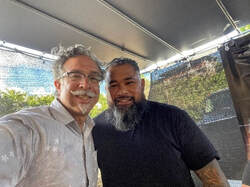 Me (with mouth swollen from trying betel nut with lime) & Su'a Peter Sulu'ape Me (with mouth swollen from trying betel nut with lime) & Su'a Peter Sulu'ape TT's parents have a lovely split level home with an open carport in a nice Honolulu neighborhood near a military base. TT isn't home, but Su'a knows we're coming and greets us upon entering the carport. A fale is set up in the carport, and the carport has been extended with awnings to create space for viewers to set off to the side. Immediately upon entering are tables with chairs around it and several bags of McDonald's someone brought (everyone brings food, so there is food arriving all day). We meet Su'a's toso and wife. Su'a is the title and name of someone who apprenticed in the Su'a guild and who was gifted the title with tatau tools by a tufuga ta tatau. Toso is the Samoan word for the stretchers, who stretch the skin so Su'a can tap. The toso include ED, a Samoan language instructor who I had been trying to contact separately, as I had learned that he has the pe'a (traditional Samoan tattoo for males) and knows all the Samoan tattoo artists. Knows? He has been toso for Su'a Peter since 2009 and travels all over the world with him. Little understatement. The other main toso is Su'a Peter's brother-in-law, who received his pe'a in November 2021 and began working with Peter as toso. We all chatted for about 30 minutes. We inquire about learning the Samoan language and are told of ideas for an online Samoan language course that might interest us but also of an app we can use to learn words and how they are pronounced. He also suggests we listen to the audio version of the Bible in Samoan, because it has more Samoan words in it than any other translated document, and it's easy to put it next to an English translation to make sense of the grammar and syntax. As we're meeting everyone, they tell us they'd just been to Alabama. I knew Su'a and TT had been there but not this whole room of people. The whole crew, Su'a and his wife, TT and her husband and parents, both main tosos, and TT's nephew had all been to Texas in March and had come to Bama to visit TT's daughter. We were supposed to get together in Bama, but our schedules didn't line up. The funny part is that got a tour of the athletic facility, including Coach Nick Saban's office. They got to sit in Saban's chair and try on his championship rings! Let me put this into context: Su'a and his wife and BIL all live in New Zealand. BIL is a rugby fan and doesn't even watch football (there is a time zone issue even the poor people of Hawaii have to deal with--noon kickoffs on the east coast is 6 am for them--that's a dedicated fan who gets up at 6am on Saturday), but he got to sit in Nick Saban's desk chair and try on the championship rings. I am a full professor at the University of Alabama, and I have not even seen inside Nick Saban's office. (Though if I'm being honest, I haven't tried and haven't toured the Bryant Museum or toured the athletic facility since I was hired in 2009, before any of Saban's championships or Heisman trophy winners, etc.). But I digress. Then Su'a and the toso went to work. There is a mat spread out on the ground for the tattooing area. Two big lights are set up behind the tufuga and fans are set up on either side to keep the bugs off and sweat down. There are customs to be followed to enter the fale: Everyone must wear ie (lavalava), shoes off, no hats or sunglasses, no video/photography/social media during sessions, and soles of one's feet should not be pointed toward elders. The toso stuff pillows into plastic bags, push all the air out, and tie them off for sanitary padding. Bandanas receive the same treatment and are used to support the 'au (the hafted tattoo instrument). Su'a Peter prepares the various 'au (which he keeps in multiple sizes in a traveling case) by tying the needles to the head of the tool. The titanium needles are soldered together and replace the traditional boar tusk that was previously carved. Boar tusk do not maintain as much sharpness, so I am told that tattooing with the titanium combs is faster, cleaner, and heals better than bone combs. To tie the needles on, he pulls out a long piece of synthetic string (like dental floss), holds the end on top of the needles with one finger, wraps the string around 20-35 times, places a small loop of string on top, passes the end of the other string through the loop, wraps it a few more times, and pulls the loop out, which tucks the end of the string into itself without the need for a knot. 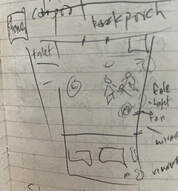 No photography, video, or live streaming during tattoo sessions, so I drew a sketch to remember the layout. No photography, video, or live streaming during tattoo sessions, so I drew a sketch to remember the layout. Now is time to start tattooing. The tufuga and toso sit cross-legged on the mat with their first client between them. The first client is a Samoan guy who came by himself from across the United States. The "by himself" part is a bit of an issue, since they're told to bring someone who can help wash them and massage the tattoo to prevent scabbing and infection. Mike (UA doctoral student Michael Smetana was my research assistant on this trip) and I move to the floor so we can watch more closely. The chairs need to be moved to the opposite side of the table away from the fale. Su'a begins marking the arc that will go on each hip. Yesterday, he started with the pe'a (bat) on the back. Today one flank, tomorrow the next, and so on over 5-10 days, depending on the number of clients. Today, he's working on parts of four pe'a and doing one whole malu. Su'a works on him for around two hours. We listen to the Sulu'ape Skinz playlist they have prepared for work, and the sound of the sousou tapping on the 'au gives a second backbeat to the music. (I always come home with a few new tunes or artists to add to my own playlists--this time it's The Five Stars and Mr. Tee). 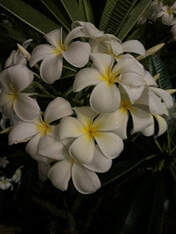 Plumeria tree, which grows all over Oahu, is a main source of flowers for lei. This is part of TT's father's garden. Plumeria tree, which grows all over Oahu, is a main source of flowers for lei. This is part of TT's father's garden. TT comes home around 11:30 AM and beckons us to the back porch area. We slip our shoes on, walk around to the back, and she shows us the yard and such (including a baby 'ava tree!). They have a giant mango tree growing in the back, and occasionally one falls, making a loud boom on the plastic roof, before it drops into the yard behind the fence and rolls down the hill! Fortunately, they must rescue enough that TT sent us home with four juicy mango. We sat in the back area chatting because it's difficult for most people not raised to it to sit cross-legged on the floor for long and because it's rude to carry on with conversation next to them tattooing. TT caught us up on their travels schedules, COVID19 issues, etc. We learned, for instance, that tattoo shops were closed for 1.5 years, so many never reopened or had to go underground to make a living. Soul Signature, the shop of Samoan-Tongan tufuga Su'a Sulu'ape Toetu'u Aisea, closed its street-level shop and moved to a high-rise, where they do work by appointment only. I had originally met Su'a Peter at the same time I met Su'a Aisea, when I stopped into Soul Signature on a Hawaii stopover just to get a sense of Polynesian tattooing in Hawaii. We were going to pop in again until we saw on their website that they weren't doing walk-in business anymore, but I had no idea they'd moved. ED comes back to talk with us and stretch out his back. The strain the tufuga and toso put their bodies through to sit on the floor for 8-16 hours is epic, and they pay the price. Other things I learned that I can share here: Su'a Paul Jr. Sulu'ape (Peter's brother) has gotten remarried, and they have a one-week-old baby boy. So I sent him a belated happy father's day via Insta, since I'm not able to get to Samoa this year. 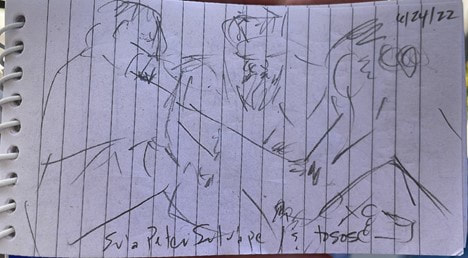 Sketch of Su'a Peter Sulu'ape & two toso (stretchers) Sketch of Su'a Peter Sulu'ape & two toso (stretchers) In addition to all the food people bring, TT makes sure they have whatever Su'a and the toso need, so there are flats of soda, water, Gatorade, Monster, Alohas, and canned cappuccino. I down a Monster while we chat, then we go back to the mat to watch the next pe'a. We watch this one all the way through, picking up the hand fans to help out keeping the bugs off. Afterward, the man's wife asks us what we're doing and chats with us about the importance of religion in Samoan tattoo. I'm fascinated and will be processing that one in my brain for a while. That in addition to a comment made that Samoans in Hawaii who belong to a Samoan church maintain the Samoan culture, and those that aren't members of a Samoan church do not, because it is the churches were the center of village life in Samoa. Everyone sits around the tables to eat some food while they take a break. I have a manapua and a can of cappuccino. Much better than the manapua I ate for dinner out of the nearby 7-11 on my first night, since nothing else was open by the time I was dealt with by the rental car company (just a little double-bind in which first my travel agent booked my rental car for the layover airport instead of the final destination, and then I forgot to renew my drivers' license before leaving). Then the other brother gets the same part of his pe'a done, which we sit and watch until around 4 or 5. Then it's time for dinner. Su'a invites Mike and I to come sit with him, and they divvy up the dinners that the two families have brought for everyone (part of their responsibility). Food is also prepared upstairs and brought in. There is a steam cooker of white rice and a meat and veggie soup. The meals are teriyaki chicken and beef, garlic shrimp, and white rice with macaroni salad on the side (to keep it cold). There are several containers of poke in coconut milk as well. After each client finishes their session, they go into the shower that is set up via a hose in a tent in the back to wash and have the tattoo massaged. After this, they help clean up the food then leave. Another family will have arrived in the meantime and are preparing for the next session. Between each client, the toso roll up the mat from the previous client, tear the bags off the pillows and replace them with new ones, strip the needles off the 'au and autoclave them. Su'a puts newly sanitized needles on with fresh string before each client. 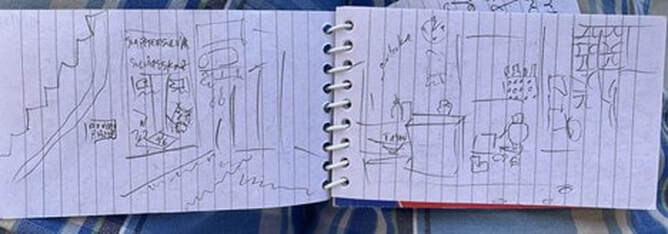 Two more sketches of the fale in the carport Two more sketches of the fale in the carport After dinner, Su'a administered a malu. Aside from making the initial arrangements and making sure the client arrives with everything they are supposed to bring, TT stays out of the art and technical aspects. So she was speculating with us as we took a break after the first leg of the malu was completed to chat. The client's father was from American Samoa, as attested by his ie, which was a tailored ie faitago with pockets and belt loops, as opposed to ie lavalava, which is called sarong in other places. This ie also suggested he might be a church leader, as the style and pattern are associated with them. Furthermore, as Tracy indicated, the double malu (the malu is the whole traditional tattoo worn by women in Samoa, but it is also the name of the main symbol of the tattoo, a diamond on the back of the thigh) is reserved for daughters of priests and similarly high-ranking people. And the mother of the girl was also wearing a dress associated with church leaders' wives. She said she thought the girl's father might be a bishop. Initially, my eyes had been drawn more to his Michigan Wolverines shirt, so I'd been planning to talk football if we started chatting. I met both of TT's parents while we were there, and they were very gracious and lovely. Her mother especially came down to watch and chat and was very generously teaching us Samoan words. She told us about her son the inventor too. He invented a toilet seat that sanitizes itself called "Washie." It's pretty ingenious, I gotta say. We've all struggled with those paper rings that we place on public toilet seats--the middle part falls in the water, gets wet and heavy, and pulls the whole ring into the water before we can land our hinies on them. Furthermore, public toilets during COVID19? Fuggetaboudit. So he invented a toilet that squirts sanitizer on the seat that you just wipe off with a little piece of toilet paper. Genius! TT was going to be the distributor (she has a few jobs), but they have licensing interest from a big public toilet company. The money is in the liquid to refill the toilet seat, so maybe Washie will be the next Harry's or something. Why not a subscription for Washie refills? When the malu started back up, we scooted back down onto the mat to watch, though by this point our hips were screaming so badly it was difficult to sit there. Don't get me wrong--tattoos are painful, very painful sometimes, and I found the handtap style even more painful than electric, though I admit it's been many years since I got an electric tattoo--but the real pain being experienced in that room is by the toso and, to a lesser extent, the tufuga. The Old Man, as all his family respectfully refer to Su'a Alaiva'a Petelo Sulu'ape, grew up sitting cross-legged everywhere and seems to suffer not at all. Su'a Paul Jr. told me how painful it is for him, that the numbness causes him problems. TT worries for Su'a Peter's health, not just because of the posture he maintains, but the long days he works. Those of us unaccustomed simply cannot hold the posture for long after the first hour or so. I switch my legs back and forth to ease pain. The mat chafes the sides of my feet, so I wrap my arms around my knees and hold them up. Later, all I can manage is to fold them under me to either side and switch back and forth. By the end of the 16 hours stretch, I had to do it very slowly because spears of pain would shoot up through my back, and I was trying to keep my poker face. Other toso popped in for shorter stints, and TT's husband came in during the 2nd or 3th pe'a as a 3rd stretcher. I can see it causes them all problems to sit that way, and it is something we all note and comment upon over the course of the days' sessions. Because this client got the double malu (malu is technically a specific pattern within the larger tatau, as the pe'a is the bat image of the male tatau, but the whole piece is also called pe'a), it took a little longer than usual, and Su'a finished her up around midnight. Even though they'd told us that he was doing parts of four pe'a, I couldn't imagine him starting another piece that late or of the person showing up ready to be tatted at that hour. But he did, and he did. Apparently, he has TT book up to five pe'a at a time sequentially in different cities, so he works under deadline and maintains his timeline hell or high water. Apparently he'd been at it till 6 the night before and 3 another night and had even worked on Sunday, which is unusual. We stayed until 3 when they wrapped up, but we did not go back the next day at 9 when they started up again. #Beastmode By the time of the last pe'a, Mike and I were both brain fried. I was groggy from dinner for a while, then started to get a headache, as the pain from my ass radiated up through my body. Around midnight I drank a Coke, ate two donuts (at our donut break), and drank a full cup of cold McDonald's coffee of the six that had been brought over earlier in the day. Helped my headache. By the time of the end of the malu and the last pe'a, my hips hurt so bad that I'd moved up to a chair behind the table. However, Su'a Peter kept an eye on everyone throughout the proceedings. When he wanted anything, he'd whisper to a toso who would turn and ask anyone but Mike or me. I think that was out of respect, but at one point I awkwardly asked him at his own house if there was anything I could get for him, just so I could feel useful. One of the things I love about working with Samoan tufuga is that he chats with the toso the whole time they work, and they laugh a lot, and I like joking around with them too. They have great senses of humor, so it's easy to cut up with Su'a. However, one of the things I don't love is that I don't know their language and so want to know what they're laughing at and never do. So there is always a bit of awkwardness in trying to relax into a situation wherein everyone is laughing but you and you have no clue what the joke is. Anyway, Su'a is keeping an eye on things, so I don't want him to catch me drifting off in the chair and bust my chops over it, so I slip back onto the floor for one last stint, figuring the pain would keep me away. Somewhere along the way I read that Samoans consider it rude to sit and write things down in front of people. So they will listen politely and, if they need to write something down, they do it after the fact. So we don't take as many notes during these sessions as we would if we didn't care about appearing rude. I say this by way of noting that there are several things I learned or that people said, but since I wasn't taking my scratch notes on pad in my pocket throughout the course of the night, I don't have an accurate recall of the order of all events. Not that it matters. Other interesting things I learned: Su'a Peter is collaborating with the same liaison I work with at the Centre for Samoan Studies at the National University of Samoa on Moana II! Su'a was the consultant for the tattoos of Maui in Moana, and they consulted him again on the script for the sequel, but they had Moana getting half a malu, then running away and leaving it unfinished until the third movie. That's something that wouldn't happen, and no one knows of it happening. The closest TT could relate was a girl who found the malu so painful that Su'a had to stop and send her home to recover herself so it could be finished the next day. Unfinished pe'a and malu are considered shameful to everyone--the tufuga, the family that paid for the tatau and put the person forward as ready, and of course the person. Unfinished pe'a are called pe'amutu, and one way to spot them is if someone has the pe'a peeking out of shorts at the knees but never takes their shirt off because they don't want people to see that they didn't get the pute (navel), which is the last part done and is in, well, the bellybutton. But that's pe'a, which takes like 30-35 hours, as opposed to the malu, which is 3-6. No island girl would run away with an unfinished malu for more than one evening if that, so Su'a Peter refused to be involved unless they fixed it from a cultural perspective. Cool, right? Su'a kept his ink in an Alabama coffee cup. I forgot to get a photo, but Roll Tide. So yeah, Su'a finished up at 3 am. We said goodbye to everyone, wobbled out, spent a few minutes discussing, then got to sleep so we could make our appointment the next morning to drive up to the pa of Kawika Au, a Hawaiian hand-tap artist I first encountered when he was stretching for at the 2018 Northwest Tatau Festival. But more on that next post... 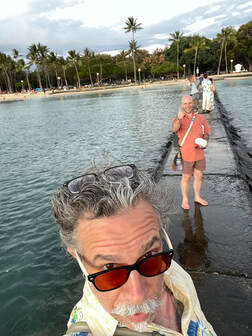 "We" is me (Chris Lynn) and doctoral student Michael Smetana, who is my research assistant this summer. Here we are exploring Waikiki Beach. "We" is me (Chris Lynn) and doctoral student Michael Smetana, who is my research assistant this summer. Here we are exploring Waikiki Beach. We're on the island of Oahu for fieldwork this summer. So of course on Facebook, Instagram, and Twitter I post the beautiful and interesting paradisiacal photos everyone expects from Hawaii, but the homelessness. I don't take photos of homeless people on purpose, but the homelessness is epidemic and startling. Not just outside the tourist zone but everywhere. Drunks, junkies, or just ill passed out in the sun right on sidewalks, at the bottom of hiking trail, in every ravine. Homeless middle aged white women looking like NYC crusty punks--sitting on sidewalks with reader glasses and flowing scarves surrounded by good looking medium-big-sized dogs leashed and with dog beds and the requisite grocery cart filled with random stuff. Don't come to Hawaii to be a free spirit; their economy cannot support you. But, weirdly, there are no stray dogs (or visible drugs sales or prostitution, but more on that later) like in the Samoan Islands and other similar locales. Dogs are leashed here. No dog poop either. Even the homeless have dogs on leashes! Over by Dole Cannery, a row of tarped tents had dogs hanging out politely. No barking or guarding--just chilling. Near the airport were tent set-ups that looked part homeless, part extended stay backpacker. The people looked clean--without the ruddiness of living outside. We saw solar pads running from under a low highway and music was pouring out. We saw well-put-together young ladies arrive on longboards, crawl in and sit. Others were vaping something inside. Another was fixing a long board. Nearby, a tent city was next to an overpass and on rafts like they were moving up and down the waterways? According to local news, a spate of evictions delayed by COVID19 is expected to increase homelessness. The website of Lt. Governor Josh Green says Hawaii homelessness is the highest per capita in the country, with 15,000 on streets; 1500-2000 are "chronic," meaning they are homeless 6 mos+ or have accompanying mental/physical issue or drug problem. Disproportionate contingent are Native Hawaiian. 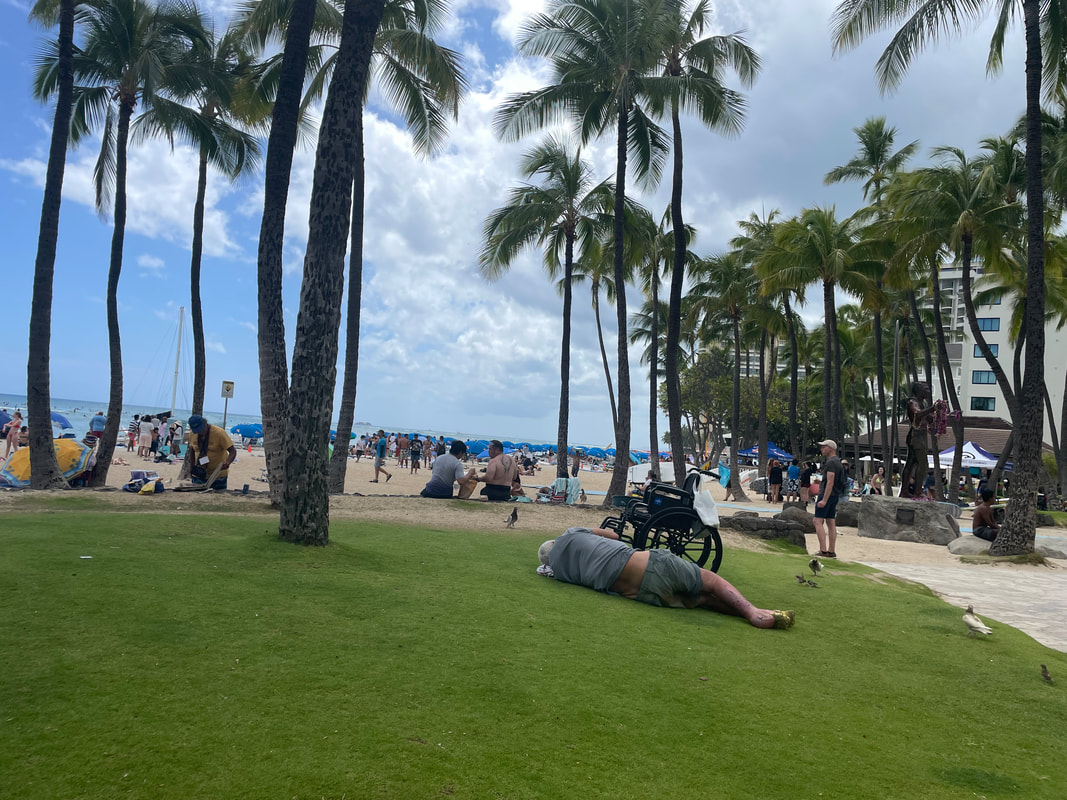 I don't take photos of homeless people on purpose, but I took a photo of the scene from my napping spot by a tree and noted the person in the foreground after the fact. Apologies, but homelessness is so ubiquitous, it is on the beaches with tourists with no one batting an eye. Cops told me to stop riding a bike on the sidewalk, but they do nothing to help. There are so many, I understand why but... TRIGGER WARNING: This episode contains discussions of self-harm.
Mel Lefebvre is a Métis, Nehiyaw, Nakota, Saulteaux, French, and Irish mother, community worker, researcher, writer, visual artist, traditional tattoo practitioner. Mel is also a PhD student at Concordia University focused on healing, decolonization, and (re)connection for Indigenous 2SLGBTQIA+ and Indigenous women. Working closely with the Native Women’s Shelter of Montreal, Mel is vice president of the board, advocating for the safety of Indigenous people as well as Indigenous representation, education, and employment. Listen here: https://soundcloud.com/inkingofimmunity/ioi-26-mel-lefebvre-talks-care-community-under-capitalism Inking of Immunity is made possible by all these people: Chris Lynn - Executive Producer & Co-host Becci Owens - Associate Producer & Co-host Mike Smetana - Associate Producer & Co-host Kira Yancey - Production Manager Find us on social media on Facebook (inking.of.immunity), Twitter (@inking_immunity), and Instagram (@inking.of.immunity) Or email us! at [email protected] 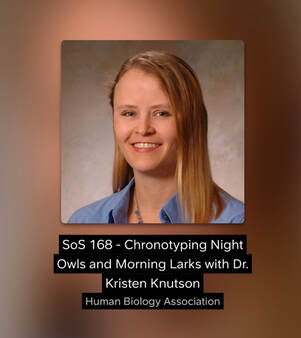 The last guest of the 5th season is Dr. Kristen Knutson, an Associate Professor of Neurology (Sleep Medicine) and Preventative Medicine (Epidemiology) at the Feinberg School of Medicine. Dr. Knutson studies the associations between sleep, circadian rhythms, and health. She chats with us about the different health outcomes between morning and night persons and tells us how a misalignment with your chronotype can lead to asthma or GI issues. Listen here! Dr. Alyssa Crittenden joins the Sausage of Science podcast for an excellent conversation (despite internet connectivity issues) about her work with Hadza community members, community-based work, and reconsidering biological sample collection. You can find her recent paper “Who Owns Poop? and Other Ethical Dilemmas Facing an Anthropologist Who Works at the Interface of Biological Research and Indigenous Rights” digitalscholarship.unlv.edu/anthro_fac_…ticles/590/. Dr. Alyssa Crittenden is an Associate Professor of Anthropology at the University of Nevada Las Vegas. You can contact her via her website: www.unlv.edu/people/alyssa-crittenden and on Twitter: @an_crittenden
Contact the Sausage of Science Podcast and Human Biology Association: Facebook: www.facebook.com/groups/humanbiologyassociation Website:humbio.org/, Twitter: @HumBioAssoc I've been terrible about posting podcast episodes because we're so busy putting them out! We wrapped season 2 last month with a few interviews, including this one with art therapists Simone Alter-Muri and Sarah Nangeroni. I really like the idea of asking people to talk about their tattoos to get at therapeutic information they might not otherwise think to share.
Listen here and remember to subscribe! Dr. Andrew Bishop joined HBERG for a year after completing a BA in New College. He wanted to apply for an anthropology grad program and needed more training in anthropology. He worked on multiple projects, accompanied Max Stein and I to Costa Rica for some fieldwork, and collaborated with Max and I on an article about how our lab works. He then went to Arizona State and earned an MA and PhD in anthropology. He told me if he didn't get a job or postdoc in the first round, he was going to apply to be on this show...
Congratulations and job well done to Julia Sponholtz for passing the defense of her thesis entitled “Eating the Valley: A Paleoethnobotanical Investigation of Local Food Use and Identity in the Cinti Valley, Bolivia in the Late Intermediate Period!”
Julia and her committee members are pictured below (L-R): Michael McKain (University of Alabama Department of Biological Sciences), Chris Lynn, Julia Sponholtz, and Katie Chiou [Stephanie McClure is on Zoom]. I am so pleased to have been a last minute addition to the dissertation committee of Lynn Funkhouser. Lynn was instrumental in helping establish our Anthropology Is Elemental outreach course, which has been on hold during COVID19, but anyway. Congrats to Lynn on her successful defense and excellent dissertation!
|
Christopher D. LynnI am a Professor of Anthropology at the University of Alabama with expertise in biocultural medical anthropology. Archives
May 2023
Categories
All
|

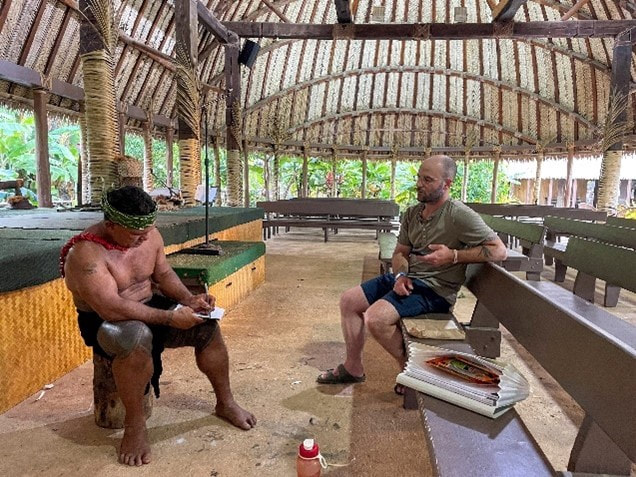
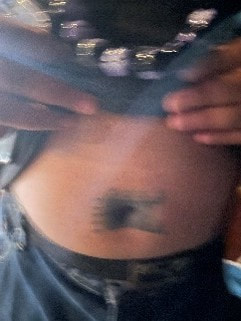
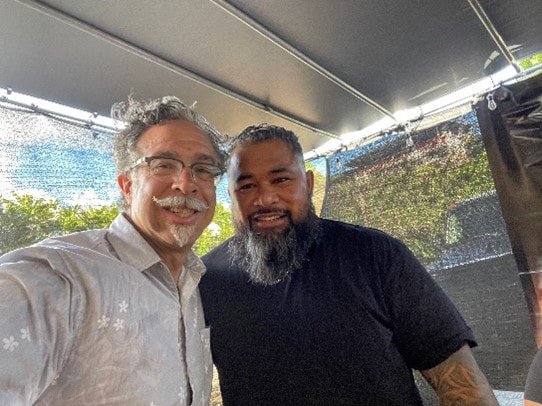
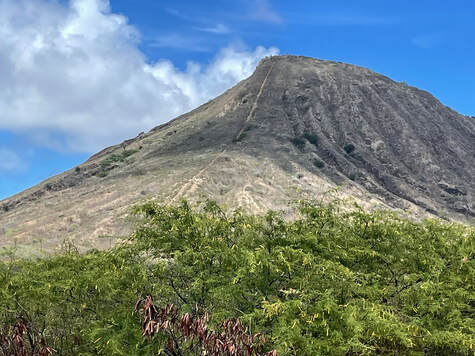
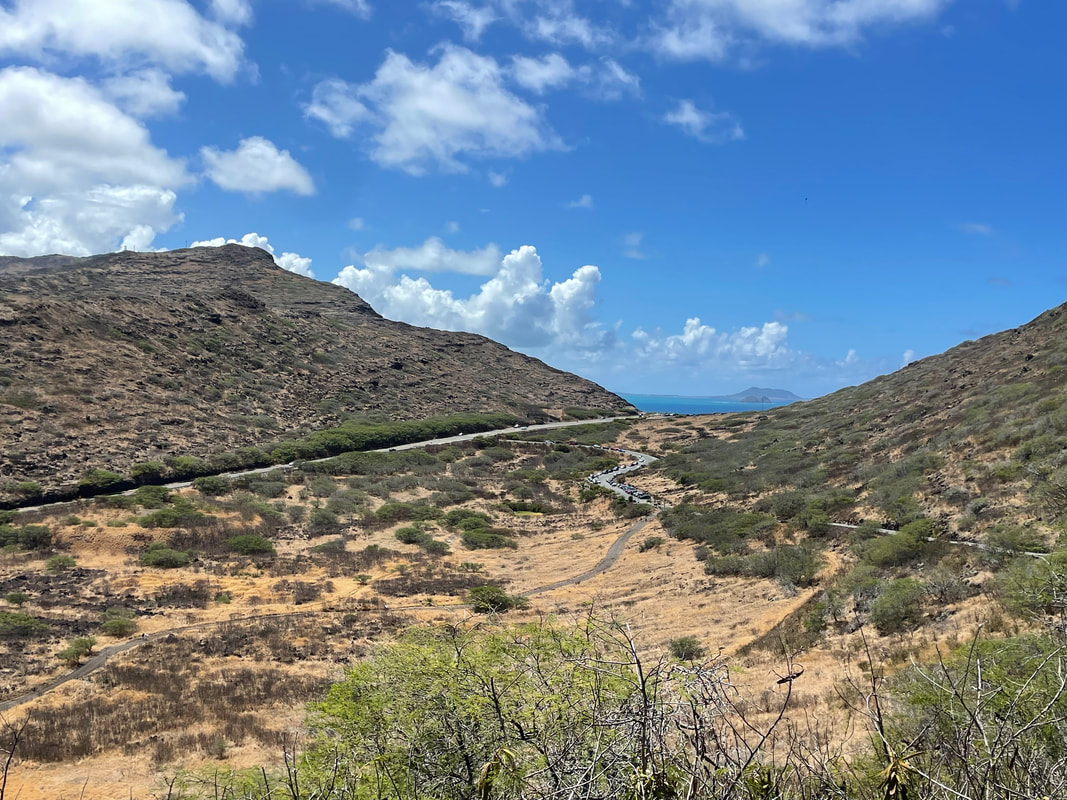
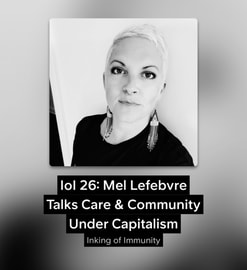


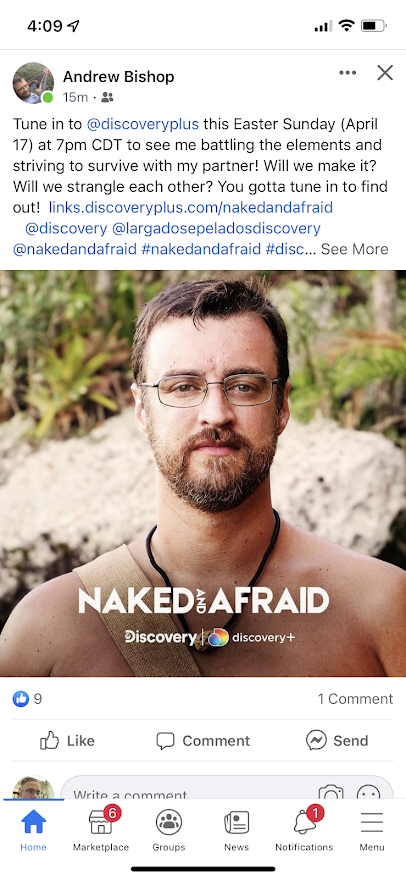
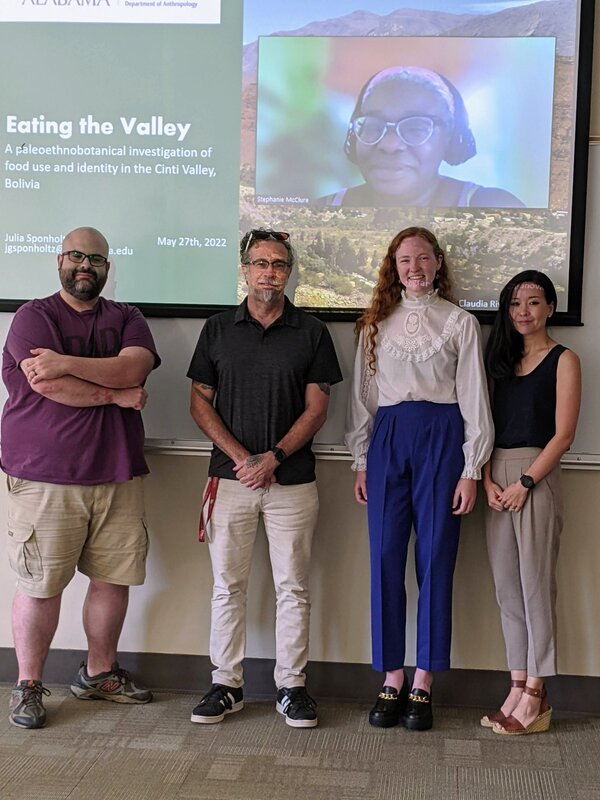
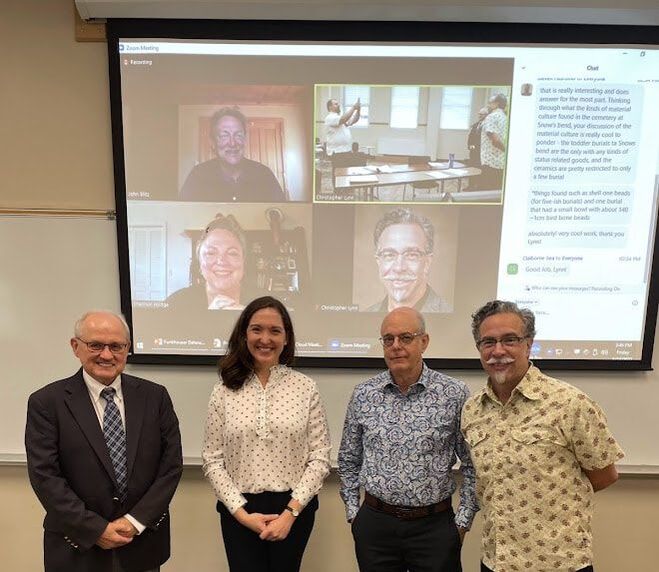
 RSS Feed
RSS Feed
